Different Types of Dental Implants Techniques & Methods
Dental implants can be applied with many techniques and methods. Our experienced dentists will decide on the most appropriate method and type for you and will give you the necessary explanation about the technique after necessary examinations.
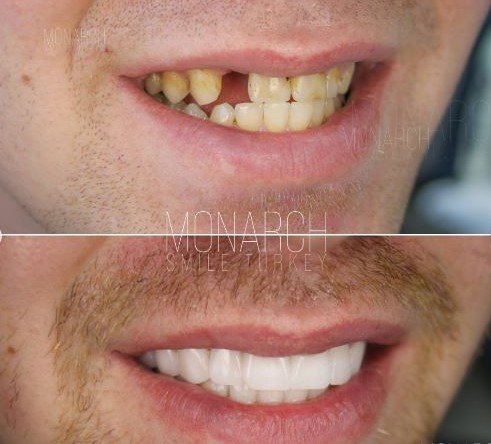
Tooth Extraction and implant
In this process, tooth extraction and implant placement are done in the same session. As soon as the patient's teeth are extracted, the implant is placed in the tooth root cavity formed in the jaw. There is no flap incision in the implant treatment using this method. This procedure is very comfortable for the patient and the physician, and the patient, under the effect of local anesthesia, does not feel pain during the process. When the front teeth of the patient are implanted, temporary prosthesis teeth are attached for smile aesthetics. If implants are made in the back teeth, temporary prosthesis teeth are attached to the patients who want a temporary prosthesis.
In contrast, temporary prosthesis teeth are not attached to patients who do not need them. In this process, pain occurs either at all or very little. It is anticipated during the implant's union with the mandible. When the fusion is complete, the implant teeth are attached.
Traditional surgical method
In the traditional surgical method , an incision is made in the areas where the implant tooth will be positioned. The screw tooth is placed in the jaw. The incision is sutured. If necessary, bone grafting is applied to increase the jaw bone density in the patient.
The sutures are removed after seven days. It takes 3-6 months for the jawbone and the implant to fuse. When the fusion is complete, permanent dentures are attached, and the treatment is completed.
Endosteal Implants:
Endosteal dental implants are the most preferred and widely used type of implants. They are placed directly into the jawbone. Categories;
Screw Type:
It is the most commonly used implant type and its appearance is screw-shaped.
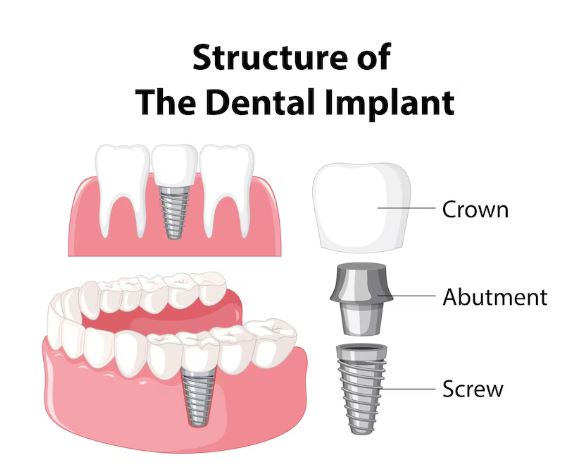
Cylinder Type:
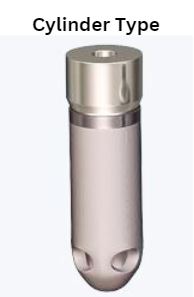
These implants have a cylindrical shape and are usually used in patients with bone deficiency.
Blade-Type:
These are rectangular and flat implants used when the jawbone is too small for cylinder or screw implants.
Subperiosteal Implants
Subperiosteal implants are positioned on top of the mandible but beneath the gum line. Patients with shallow jawbones who are unable or unwilling to have their bone augmented are treated with them. A metal frame is inserted behind the mandible's gum tissue. The frame joins the jawbone once the gums have healed.
Seamless implant - Flapness implant
Seamless method is done with the closed technique.No part of the patient's mouth is flapped. In order to place the implant, an x-ray film is taken, and the slot in the jawbone where the implant will be placed is opened with a punch tool. After the slot is opened, the implant is inserted. Since there are no flaps, incisions or stitches, the possibility of infection after this procedure is very low. The crown is attached once the implant and the jawbone have fused.
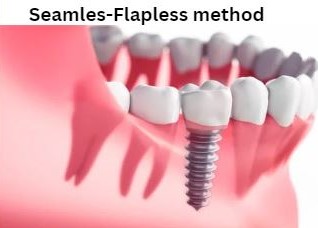
Seamless implant treatment is preferred by dentists, especially in patients who smoke, because the risk of infection is low. Seamless dental implant treatment is performed with a closed technique. No flaps (incisions) are made on the patient's gums, and this reduces the likelihood of any complications occurring.
In dental implant treatment, the patient's jawbone width must be sufficient for seamless implant treatment. This method can be used if it is determined that your jawbone tissue and width are sufficient in the examinations performed by our experienced dentist before starting the treatment.
Mini Dental Implants (MDIs)
This method is applied to the points where bone resorption can be seen in case the patient's tooth is extracted. The main purpose of using mini implants in posterior teeth is to prevent bone resorption in the patient's jaw in the future and to prevent the patient from needing bone grafting, which is one of the advanced surgical methods. Usually, a mini dental implant is applied for the posterior teeth. After the fusion process of the jawbone and the implant, the implant teeth are attached.
Mini dental implants are less intrusive than standard implants because of their smaller diameter, and they are frequently used to stabilise dentures.
Mini implants are the best option for people who have less bone density or who want a less intrusive procedure.
Zygomatic Implants
When there is insufficient bone volume or density in the upper jawbone, zygomatic implants are utilised. Instead of being anchored in the maxilla (upper jaw), they are in the zygoma, or cheekbone. These longer implants provide an option for patients whose significant bone loss precludes them from obtaining regular implants.

Zigomatic implants exhibit greater distinctions from classical implants. This implant is larger. For patients who have never had an implant in their upper face, ziggomatic implantation is a technique utilised. Patients with very severe bone resorption are treated with this implant. Normal implants have a length of 8-10-12 mm, whereas zigomatic implants have a length of 30-50 mm.
The zygomatic implant technique is used in patients with severe bone resorption in the upper jaw - when even a small implant cannot be placed.
Implants implanted in the cheekbone are known as zygomatic implants. The bone that connects the upper jawbone is called the zygomatic bone. The zygomatic bone can be used if the upper jaw bone is not large enough for the implant. Due to the large distance of the zygomatic bone, a 40 mm long 30 mm zygomatic implant is placed in the upper jaw area.
Since ziggomatic implants usually need to be removed after years, they are used by people who wear total prostheses. If patients are toothless for a long period of time, the jawbone is completely dissolved. In fact, this bone resorption is so advanced that even if bone graft transplantation is performed, there is not enough space to place the implant. This type of implant is also used for patients who have difficulty using dentures, who have lost their teeth at an early age or who have recently lost their teeth due to genetic problems.
Immediate Load Implants (Teeth in a Day)
With immediate implants, a temporary tooth can be inserted at the same session as the implant. Appropriate for individuals with sufficient bone density and an implant stable enough to facilitate prompt implantation.
All on Four Dental Implants

With the All on 4 procedure, a complete arch of teeth is supported by four implants that are inserted into the jawbone.When a patient needs all of their upper or lower teeth and wants a quicker, more effective alternative than traditional individual implants, they frequently employ this approach.
All on 6 Dental Implants
The All-on-Six treatment entails inserting six implants into the mandible. For this operation, conventional implants that are customised to the patient's specific bone structure are required. Enough bone density must exist in the posterior locations where the implants are placed in order to use the All on Six procedure. The All-on-Six technique provides a more natural appearance and increased protection against problems like food entrapment due to the density of implant implantation.
The new technique for dental implants: Laser-assisted implant insertion
The precise and exact placement of implants has increased with the use of laser-guided technologies. By combining 3D imaging and laser aid to determine the ideal location for the implant, dentists can guarantee the greatest results.
Implant Supported Dentures
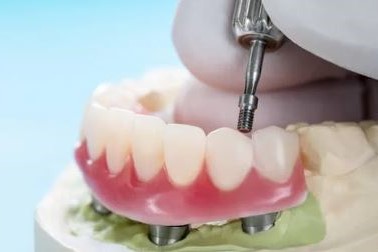
All missing teeth are replaced with complete dentures, which are secured in place by implants placed into the jaw. A complete denture is used to replace missing teeth in a jaw when all of the teeth have been gone. Teeth extraction is possible for a complete denture. The dentist creates a complete denture once all of the teeth have been lost. This denture depends solely on the gums, as opposed to partial dentures.
As Monarchsmileturkey dental clinic, we determine the implant technique that will meet the needs of our patients, eliminate their discomfort and make them aesthetically happy by working specifically for our patients. Dental implants require meticulous application at every stage of the process. If necessary, orthodontic treatment before implant treatment and taking the correct measurements are essential for the success of the implant process.
- For more detailed information, please contact us or visit us at our dental clinic.
